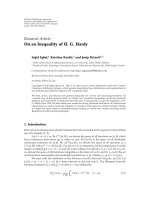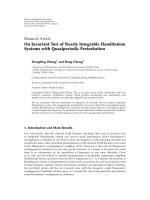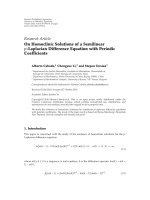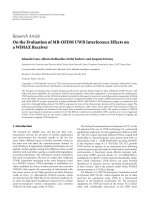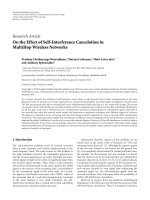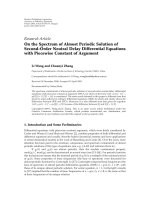Báo cáo hóa học: " Research Article On Star Duality of Mixed Intersection Bodies" pptx
Bạn đang xem bản rút gọn của tài liệu. Xem và tải ngay bản đầy đủ của tài liệu tại đây (531.39 KB, 12 trang )
Hindawi Publishing Corporation
Journal of Inequalities and Applications
Volume 2007, Article ID 39345, 12 pages
doi:10.1155/2007/39345
Research Article
On Star Duality of Mixed Intersection Bodies
Lu Fenghong, Mao Weihong, and Leng Gangsong
Received 7 July 2006; Revised 22 October 2006; Accepted 30 October 2006
Recommended by Y. Giga
A new kind of duality between intersection bodies and projection bodies is presented.
Furthermore, some inequalities for mixed intersection bodies are established. A geomet-
ric inequality is derived between the volumes of star duality of star bodies and their asso-
ciated mixed intersection integral.
Copyright © 2007 Lu Fenghong et al. This is an open access article distributed under the
Creative Commons Attribution License, which permits unrestricted use, distribution,
and reproduction in any medium, provided the original work is properly cited.
1. Introduction and main results
Intersection bodies were first explicitly defined and named by Lutwak [1]. It was here that
the duality between intersection bodies and projection bodies was first made clear. De-
spite considerable ingenuity of earlier attacks on the Busemann-Petty problem, it seems
fair to say that the work of Lutwak [1] represents the beginning of its eventual solu-
tion. In [1], Lutwak also showed that if a convex body is sufficiently smooth and not
an intersection body, then there exists a centered star body such that the conditions of
Busemann-Petty problem hold, but the result inequality is reversed. Following Lutwak,
the intersection body of order i of a star body is introduced by Zhang [2]. It follows from
this definition that every intersection body of order i of a star body is an intersection body
of a star body, and vice versa. As Zhang observes, the new definition of intersection body
allows a more appealing formulation, namely, the Busemann-Petty problem has a posi-
tive answer in n-dimensional Euclidean space if and only if each centered convex body is
an intersection body. The intersection body plays an essential role in Busemann’s theory
[3] of area in Minkowski spaces.
In [4], Moszy
´
nska introduced the notion of the star dual of a star body. Generally, star
dual of a convex body is different from its polar dual. For every convex body K,letK
∗
and K
o
denote the polar body and the star dual of K, respectively.
2 Journal of Inequalities and Applications
In recent years, some authors including Haberl and Ludwig [5], Kalton and Koldob-
sky [6], Klain [7, 8], Koldobsky [9], Ludwig [10, 11], and so on have given considerable
attention to the intersection bodies and their various properties. The aim of this paper
is to establish several inequalities about the star dual version of intersection bodies. We
establish the star dual version of the general Busemann intersection inequality.
Theorem 1.1. Let K
1
, ,K
n−1
be star bodies in R
n
. Then
V
K
1
···
V
K
n−1
V
I
o
K
1
, ,K
n−1
≥
ω
n
ω
n−1
n
(1.1)
with equality if and only if K
1
, ,K
n−1
are dilates of centered balls.
Theorem 1.1 is an analogue of the general Petty projection inequality which was given
by Lutwak [12], concerning the polar duality of convex bodies.
Theorem 1.2. Let K
1
, ,K
n−1
be convex bodies in R
n
. Then
V
K
1
···
V
K
n−1
V
Π
∗
K
1
, ,K
n−1
≤
ω
n
ω
n−1
n
(1.2)
with equality if and only if K
1
, ,K
n−1
are homothetic ellipsoids.
For two star bodies K and L,letK
˘
+L denote the radial Blaschke sum of K and L [1]. We
establish the dual Brunn-Minkowski inequality for the star duality of mixed intersection
bodies concerning the radial Blaschke sum.
Theorem 1.3. If K, L are star bodies in
R
n
and 0 ≤ i<n, then
W
i
I
o
K
˘
+L
−1/(n−i)
≥
W
i
I
o
K
−1/(n−i)
+
W
i
I
o
L
−1/(n−i)
(1.3)
with equality if and only if K and L are dilates. For i>n,inequality(1.3)isreversed.
Theorem 1.3 is an analogue of the general Brunn-Minkowski inequality for the polar
duality of mixed projection bodies concerning the Blaschke sum [1].
Theorem 1.4. If K, L are convex bodies in
R
n
and 0 ≤ i<n, then
W
i
Π
∗
K
˙
+L
−1/(n−i)
≥
W
i
Π
∗
K
−1/(n−i)
+
W
i
Π
∗
L
−1/(n−i)
(1.4)
with equality if and only if K and L are dilates. For i>n,inequality(1.4)isreversed.
Besides, we establish the fol lowing relationship between star duality and intersection
operator I.
Theorem 1.5. If K
1
, ,K
n−1
are star bodies in R
n
, then
ω
2
n
−1
I
o
K
1
, ,K
n−1
⊂
I
K
o
1
, ,K
o
n
−1
(1.5)
with equality if and only if K
1
, ,K
n−1
are dilates of centered balls.
Lu Fenghong et al. 3
In Section 2, some basic definitions and facts are restated. The elementary results (and
definitions) are from the theory of convex bodies. The reader may consult the standard
works on the subject [13, 14] for reference. Some properties and inequalities of star du-
ality are established in Section 3. A general Busemann intersection inequality and its star
dual forms are derived; the Brunn-Minkowski inequalities for the star dual and other
inequalities are given in Section 4. By using the inequalities concerning star duality of
mixed intersection bodies, a geometric inequality is derived between the volumes of star
duality of star bodies and their associated mixed intersection integr al in Section 5.
2. Basic definitions and notation
As usual, let B denote the unit ball in Euclidean n-space,
R
n
. While its boundary is S
n−1
and the origin is denoted by o,letω
i
denote the volume of the i-dimensional unit ball.
If u is a unit vector, that is, an element of S
n−1
, we denote by u
⊥
the (n − 1)-dimensional
linear subspace orthogonal to u.
For a compact subset L of
R
n
,witho ∈ L, star-shaped w ith respect to o,theradial
function ρ(L,
·):S
n−1
→ R is defined by
ρ(L,u)
= ρ
L
(u) = max{λ : λu ∈ L}. (2.1)
If ρ(L,
·) is continuous and positive, L will be called a star body.
Let
n
o
denote the set of star bodies in R
n
.TwostarbodiesK,L ∈
n
o
are said to be
dilatate(of each other) if ρ(K,u)/ρ(L,u)isindependentofu
∈ S
n−1
.
2.1. Dual-mixed volume. If x
i
∈ R
n
,1≤ i ≤ m,thenx
1
+···
+x
m
is defined to be the
usual vector sum of the points x
i
, if all of them are contained in a line through or igin, and
0 otherwise.
If K
i
∈
n
o
and t
i
≥ 0, 1 ≤ i ≤ m, then the radial linear combination, t
1
K
1
+···
+t
m
K
m
,
is defined by
t
1
K
1
+···
+t
m
K
m
=
t
1
x
1
+···
+t
m
x
m
: x
i
∈ K
i
. (2.2)
Moreover , for each u
∈ S
n−1
,
ρ
t
1
K
1
+t
2
K
2
(u) = t
1
ρ
K
1
(u)+t
2
ρ
K
2
(u). (2.3)
If L
∈
n
o
, then the polar coordinate formula for volume is
V(L)
=
1
n
S
n−1
ρ
L
(u)
n
dS(u). (2.4)
Let L
j
∈
n
o
(1 ≤ j ≤ n). The dual-mixed volume
V(L
1
, ,L
n
)isdefinedbyLutwakin
[15, 16]by
V
L
1
, ,L
n
=
1
n
S
n−1
ρ
L
1
(u)···ρ
L
n
(u)dS(u). (2.5)
If K
1
= ··· = K
n−i
= K, K
n−i+1
= ··· = K
n
= L, the dual-mixed volumes are written as
V
i
(K,L) and the dual-mixed volumes
V
i
(K,B)arewrittenas
W
i
(K).
4 Journal of Inequalities and Applications
Let L
∈
n
o
, i ∈ R
n
, the dual quermassintegrals
W
i
(L)isdefinedbyLutwakin[15]by
W
i
(L) =
1
n
S
n−1
ρ
L
(u)
n−i
dS(u). (2.6)
If K is a star body in
R
n
and u ∈ S
n−1
, then we use K ∩ u
⊥
to denote the intersec-
tion of K with the subspace u
⊥
that passes through the origin and is orthogonal to u.
If K
1
, ,K
n−1
are star bodies in R
n
and u ∈ S
n−1
, then the (n − 1)-dimensional dual-
mixed volume of K
1
∩ u
⊥
, ,K
n−1
∩ u
⊥
in u
⊥
is written v(K
1
∩ u
⊥
, ,K
n−1
∩ u
⊥
). If
K
1
=··· =K
n−i−1
= K and K
n−i
=··· =K
n−1
= B,thenv(K
1
∩ u
⊥
, ,K
n−1
∩ u
⊥
)isjust
the ith dual quermassinteg rals of K
∩ u
⊥
in u
⊥
, it will be denoted by w
i
(K ∩ u
⊥
)andis
called the (n
− i− 1)-section of K in the direction u.The(n − 1)-dimensional volume of
K
∩ u
⊥
will be written v(K ∩ u
⊥
) rather than w
0
(K ∩ u
⊥
).
2.2. Mixed intersection bodies. Let K
∈
n
o
. The intersection body IK of K is a star body
such that [1]
ρ
IK
(u) = v
K ∩ u
⊥
=
1
n − 1
S
n−1
∩u
⊥
ρ
K
(v)
n−1
dλ
n−2
(v), (2.7)
where λ
i
denote the i-dimensional volume.
Let K
1
, ,K
n−1
∈
n
o
. The mixed intersection body I(K
1
, ,K
n−1
)ofstarbodies
K
1
, ,K
n−1
is defined by
ρ
I(K
1
, ,K
n−1
)
(u) =
v
K
1
∩ u
⊥
, ,K
n−1
∩ u
⊥
=
1
n − 1
S
n−1
∩u
⊥
ρ
K
1
(v)···ρ
K
n−1
(v)dλ
n−2
(v).
(2.8)
If K
1
=··· =K
n−i−1
= K, K
n−i
=··· =K
n−1
= L,thenI(K
1
, ,K
n−1
) will be denoted
as I
i
(K,L). If L = B,thenI
i
(K,B) is called the intersection body of order i of K;itwill
often be written as I
i
K.Specially,I
0
K = IK. This term was introduced by Zhang [2].
Let K
∈
n
o
and i ∈ R, the intersection body of order i of K is the centered star body
I
i
K such that [2]
ρ
I
i
K
(u) =
1
n − 1
S
n−1
∩u
⊥
ρ
n−1−i
K
(v)dλ
n−2
(v). (2.9)
If K,L
∈
n
o
and λ,μ ≥ 0 (not both zero), then for each u ∈ S
n−1
, the radial Blaschke
linear combination, λ
· K
˘
+μ · L, is the star body whose radial function is given by [15]
ρ(λ
· K
˘
+μ · L,u)
n−1
= λρ(K,u)
n−1
+ μρ(L,u)
n−1
. (2.10)
It is easy to verify the following relation between radial Blaschke and ra dial Minkowski
scalar multiplication: if K
∈
n
o
and λ ≥ 0, then λ · K = λ
1/(n−1)
K.
Lu Fenghong et al. 5
The following properties will be used later: if K,L
∈
n
o
and λ,μ ≥ 0, then
I(λ
· K
˘
+μ · L) = λIK
+μIL. (2.11)
3. Inequalities for s tar duality of star body
Also associated with a star body L
∈
n
o
is its star duality L
o
, which was introduced by
Moszy
´
nska [4](and was improved in [17]). Let i be the inversion of
R
n
\{0}, with respect
to S
n−1
,
i(x):
=
x
x
2
. (3.1)
Then the star duality L
o
of a star body L ∈
n
o
is defined by
L
o
= cl
R
n
\i(L)
. (3.2)
It is easy to verify that for every u
∈ S
n−1
[4],
ρ
L
o
,u
=
1
ρ(L,u)
. (3.3)
By applying the conception of star duality, we establish the following properties for
star body and its star duality.
Theorem 3.1. If K
∈
n
o
and i ∈ R, then
W
2n−i
K
o
=
W
i
(K). (3.4)
Proof. From definition (2.6), equality (3.3), and definition (2.6)again,wehave
W
2n−i
K
o
=
1
n
S
n−1
ρ
K
o
,u
n−(2n−i)
dS(u) =
1
n
S
n−1
ρ(K,u)
n−i
dS(u) =
W
i
(K). (3.5)
In particular, for i = 0inTheorem 3.1,wehave
W
2n
K
o
=
V(K). (3.6)
The following statement is an analogue of the Blaschke-Santal
´
o inequality [3] for dual
quermassintegrals of star bodies.
Theorem 3.2. If K
∈
n
o
and i ∈ R, then
W
i
(K)
W
i
K
o
≥
ω
2
n
(3.7)
with equality if and only if K is a cen tered ball.
6 Journal of Inequalities and Applications
Proof. From equality (3.3), H
¨
older inequality [18], and definition (2.6), we have
ω
n
=
1
n
S
n−1
1dS(u) =
1
n
S
n−1
ρ(K,u)
(n−i)/2
ρ(K,u)
−(n−i)/2
dS(u)
=
1
n
S
n−1
ρ(K,u)
(n−i)/2
ρ
K
o
,u
(n−i)/2
dS(u)
≤
1
n
S
n−1
ρ(K,u)
n−i
dS(u)
1/2
1
n
S
n−1
ρ
K
o
,u
n−i
dS(u)
1/2
=
W
i
(K)
1/2
W
i
K
o
1/2
.
(3.8)
According to the equality condition of H
¨
older inequality, we know that equality in in-
equality (3.7) holds if and only if K is a centered ball.
In particular, for i = 0inTheorem 3.2, we have the following.
Corollar y 3.3. If K
∈
n
o
, then
V(K)V
K
o
≥
ω
2
n
(3.9)
with equality if and only if K is a cen tered ball.
Inequality (3.9) just is an analogue of the Blaschke-Santal
´
o inequality [3]ofconvex
bodies.
Corollar y 3.4. If K is a convex body in
R
n
, then
V(K)V
K
∗
≤
ω
2
n
(3.10)
with equality if and only if K is an ellipsoid.
4. Star dual intersection inequalities
The following theorem is the general Busemann intersection inequality involving the vol-
ume of a convex body and that of its associated intersection bodies.
Theorem 4.1 (general Busemann intersection inequality). Let K
1
, ,K
n−1
be star bodies
in
R
n
.Then,
V
I
K
1
, ,K
n−1
≤
ω
n
n
−1
ω
n−2
n
V
K
1
···
V
K
n−1
(4.1)
w ith equality if and only if all K
1
, ,K
n−1
are dilates of centered ellipsoids.
Lu Fenghong et al. 7
Let K
1
=··· =K
n−1
= L in Theorem 4.1, we get the Busemann intersection inequality,
which was established by Busemann [19].
Corollar y 4.2. If K is a star body in
R
n
, then
V(IK)
≤
ω
n
n
−1
ω
n−2
n
V(K)
n−1
(4.2)
with equality if and only if K is a cen tered ellips oid.
Proof of Theorem 4.1. From definition (2.4), definition (2.8), H
¨
older inequality [18], def-
inition (2.7), H
¨
older inequality, definition (2.4) again, and inequality (4.2), it follows that
V
I
K
1
, ,K
n−1
=
1
n
S
n−1
ρ
I
K
1
, ,K
n−1
,u
n
dS(u)
=
1
n
S
n−1
1
n − 1
S
n−1
∩u⊥
ρ
K
1
,v
···
ρ
K
n−1
,v
dλ
n−2
(v)
n
dS(u)
≤
1
n
S
n−1
1
n − 1
S
n−1
∩u⊥
ρ
K
1
,v
n−1
dλ
n−2
(v)
n/( n−1)
×···
1
n − 1
S
n−1
∩u⊥
ρ
K
n−1
,v
n−1
dλ
n−2
(v)
n/( n−1)
dS(u)
=
1
n
S
n−1
ρ
IK
1
,u
···
ρ
IK
n−1
,u
n/( n−1)
dS(u)
≤
1
n
S
n−1
ρ
IK
1
,u
n
dS(u)
1/(n−1)
×···
1
n
S
n−1
ρ
IK
n−1
,u
n
dS(u)
1/(n−1)
= V
IK
1
1/(n−1)
···V
IK
n−1
1/(n−1)
≤
ω
n
n
−1
ω
n−2
n
V
K
1
···
V
K
n−1
.
(4.3)
According to the equality conditions of H
¨
older inequality and inequality (4.2), equality
holds in inequality (4.1)ifandonlyifK
i
are dilates of centered ellipsoids.
The following statement is the star duality of the general Busemann intersection in-
equality.
Theorem 4.3. Let L
1
, ,L
n−1
be star bodies in R
n
.Then,
V
L
1
···
V
L
n−1
V
I
◦
L
1
, ,L
n−1
≥
ω
n
ω
n−1
n
(4.4)
w ith equality if and only if all L
i
(i = 0,1, ,n − 1) are dilates of centered balls.
8 Journal of Inequalities and Applications
Proof. Combing inequality (3.9)withinequality(4.1), we have
V
K
1
···
V
K
n−1
V
I
o
K
1
, ,K
n−1
≥
ω
n
ω
n−1
n
. (4.5)
According to the equality conditions of inequality (3.9) and inequality (4.1), equality
holds if and only if K
i
(i = 0,1, ,n − 1) are dilates of centered balls.
Theorem 4.3 is an analogue of the general Petty projection inequality which was given
by Lutwak [12] concerning the polar duality of convex bodies.
In particular, let L
1
=··· =L
n−1
= L in Theorem 4.3, we get the following.
Corollar y 4.4. Let L
∈
n
o
.Then,
V(L)
n−1
V
I
◦
L
≥
ω
n
ω
n−1
n
(4.6)
with equality if and only if L is a centered ball.
This is just an analogue of the Petty projection inequalit y concerning the polar duality
of convex bodies, which was given by Petty [20].
Corollar y 4.5. Let K be a convex body in
R
n
.Then,
V(K)
n−1
V
Π
∗
K
≤
ω
n
ω
n−1
n
(4.7)
with equality if and only if K is an ellipsoid.
There is a relationship between star duality and the operator I.
Theorem 4.6. If K
1
, ,K
n−1
∈
n
o
, then
ω
2
n
−1
I
o
K
1
, ,K
n−1
⊂
I
K
o
1
, ,K
o
n
−1
(4.8)
with equality if and only if K
1
, ,K
n−1
are dilates of centered balls.
Proof. From equality (3.3), definition (2.8), and H
¨
older inequality [18], we obtain
ρ
I
o
K
1
, ,K
n−1
,u
−1
ρ
I
K
o
1
, ,K
o
n
−1
,u
=
ρ
I
K
1
, ,K
n−1
,u
ρ
I
K
o
1
, ,K
o
n
−1
,u
=
1
(n − 1)
2
S
n−1
∩u
⊥
ρ
K
1
(v)···ρ
K
n−1
(v)dλ
n−2
(v)
S
n−1
∩u
⊥
ρ
K
o
1
(v)···ρ
K
o
n
−1
(v)dλ
n−2
(v)
≥
1
(n − 1)
2
S
n−1
∩u
⊥
1dλ
n−2
(v)
2
= ω
2
n
−1
.
(4.9)
Thus we get the inequality (4.8).
Lu Fenghong et al. 9
According to the equality conditions of H
¨
older inequality, equality in inequality (4.8)
holds if and only if K
i
are dilates of centered balls.
In particular, for K
1
= ··· = K
n−1−i
= K, K
n−i
= ··· = K
n−1
= B in Theorem 4.6,we
have the following statement which is a result of [4].
Corollar y 4.7. If K
∈
n
o
and 0 ≤ j<n− 1, then
ω
2
n
−1
I
o
j
K ⊂ I
j
K
o
(4.10)
with equality if and only if K is a cen tered ball.
By using Theorem 4.6, we obtain the following t heorem.
Theorem 4.8. If K
1
, ,K
n−1
∈
n
o
, then
(i)
V
I
K
1
, ,K
n−1
V
I
K
o
1
, ,K
o
n
−1
≥
ω
2
n
ω
2n
n
−1
, (4.11)
(ii)
V
K
1
···
V
K
n−1
V
I
K
o
1
, ,K
o
n
−1
≥
ω
n
ω
n−1
n
(4.12)
w ith equality in each inequality if and only if K
1
, ,K
n−1
are dilates of centered ball.
Proof. (i) From inequality (4.8) and inequality (3.9), we have
V
I
K
1
, ,K
n−1
V
I
K
o
1
, ,K
o
n
−1
≥
ω
2n
n
−1
V
I
K
1
, ,K
n−1
V
I
K
o
1
, ,K
o
n
−1
≥
ω
2
n
ω
2n
n
−1
.
(4.13)
According to the equality conditions of inequality (4.8) and inequality (3.9), equality in
inequality (4.11) holds if and only if K
i
are dilates of centered balls.
(ii) From inequality (4.1) and inequality (4.11), we get
ω
2
n
ω
2n
n
−1
≤ V
I
K
1
, ,K
n−1
V
I
K
o
1
, ,K
o
n
−1
≤
ω
n
n
−1
ω
n−2
n
V
K
o
1
···
V
K
o
n
−1
V
I
K
1
, ,K
n−1
.
(4.14)
Therefore, we obtain inequality (4.12).
According to the equality conditions of inequality (4.1) and inequality (4.11), equality
in inequality (4.12) holds if and only if K
i
are dilates of centered balls.
10 Journal of Inequalities and Applications
Proof of Theorem 1.3. From definition (2.6), equality (3.3), equality (2.11), Minkowski
integral inequality [18], and definition (2.6) again, it follows that for 0
≤ i<n,
W
i
I
o
K
˘
+L
−1/(n−i)
=
1
n
S
n−1
ρ
I
o
K
˘
+L
,u
n−i
dS(u)
−1/(n−i)
=
1
n
S
n−1
ρ
I
K
+L
,u
−(n−i)
dS(u)
−1/(n−i)
=
1
n
S
n−1
ρ(IK,u)+ρ(IK, u)
−(n−i)
dS(u)
−1/(n−i)
≥
1
n
S
n−1
ρ(IK,u)
−(n−i)
dS(u)
−1/(n−i)
+
1
n
S
n−1
ρ(IK,u)
−(n−i)
dS(u)
−1/(n−i)
=
W
i
I
o
K
−1/(n−i)
+
W
i
I
o
L
−1/(n−i)
.
(4.15)
According to the equality conditions of Minkowski inequality, equality in inequality (1.5)
holds if and only if K and L are dilates. For i>n, inequality (1.3)isreversed.
5. Mixed intersection integrals
For star bodies K
1
, ,K
n
in R
n
and a fixed integer r with 0 ≤ r<n, we define the rth
mixed intersection integral of K
1
, ,K
n
by
J
r
K
1
, ,K
n
=
ω
n−r−2
nω
n
n
−1
S
n−1
w
r
K
1
∩ u
⊥
···
w
r
K
n
∩ u
⊥
dS(u). (5.1)
For K
1
=··· =K
n
= B, a trivial computation shows that
J
r
(B, ,B) = ω
n−r−1
n
. (5.2)
The following lemma will be used later.
Lemma 5.1. K,L
∈
n
o
and 0 ≤ r<n− 1, then
V
I
o
r
K
=
1
n
S
n−1
w
r
K ∩ u
⊥
−n
dS(u). (5.3)
From definition (2.4), definition (2.9), Lemma 5.1 easily follows.
Lu Fenghong et al. 11
For 0
≤ r<n− 1, apply the H
¨
older inequality, use equality (5.3), and we obtain
1
n
S
n−1
w
r
K
1
∩ u
⊥
···
w
r
K
n
∩ u
⊥
−1
dS(u)
n
≤ V
I
o
r
K
1
···
V
I
o
r
K
n
(5.4)
with equality if and only if (for all i, j)the(n
− 1 − r)-sections of K
i
and K
j
are propor-
tional.
From Jensen’s inequality [18], we get
nω
n−r
n
≤ ω
n
n
−1
J
r
K
1
, ,K
n
1
n
S
n−1
w
r
K
1
∩ u
⊥
···
w
r
K
n
∩ u
⊥
−1
dS(u). (5.5)
If we combine inequalities (4.2), (4.10), (5.4), and (5.5), we obtain the following.
Theorem 5.2. If K
1
, ,K
n−1
are star bodies in R
n
and 0 ≤ r<n− 1, then
ω
2n(n−r−1)
n
≤ J
r
K
1
, ,K
n
n
V
K
o
1
, ,K
o
n
n−r−1
(5.6)
with equality if and only if K
1
, ,K
n
are centered balls.
Theorem 5.2 is just an analogue of the geometric inequality between the volumes of
convex bodies and their associated mixed projection integrals which was given by Lutwak
[12].
Acknowledgments
This work was supported in part by National Natural Sciences Foundation of China
(10671117). The authors wish to thank the referees for their very helpful comments and
suggestions on the original version of this paper.
References
[1] E. Lutwak, “Intersection bodies and dual mixed volumes,” Advances in Mathematics, vol. 71,
no. 2, pp. 232–261, 1988.
[2] G. Y. Zhang, “Centered bodies and dual mixed volumes,” Transactions of the American Mathe-
matical Society, vol. 345, no. 2, pp. 777–801, 1994.
[3] L. Santal
´
o, “Un invariante afin para los cuerpos convexos del espacio de n dimeniones,” Portu-
galiae Mathematica, vol. 8, no. 4, pp. 155–161, 1949.
[4] M. Moszy
´
nska, “Quotient star bodies, intersection bodies, and star duality,” Journal of Mathe-
matical Analysis and Applications, vol. 232, no. 1, pp. 45–60, 1999.
[5] C. Haberl and M. Ludwig, “A character ization of L
p
intersection bodies,” International Mathe-
matics Research Notices, vol. 2006, Article ID 10548, 29 pages, 2006.
[6] N. J. Kalton and A. Koldobsky, “Intersection bodies and L
p
-spaces,” Advances in Mathematics,
vol. 196, no. 2, pp. 257–275, 2005.
[7] D. A. Klain, “Star valuations and dual mixed volumes,” Advances in Mathematics, vol. 121, no. 1,
pp. 80–101, 1996.
[8] D. A. Klain, “Invariant valuations on star-shaped sets,” Advances in Mathematics, vol. 125, no. 1,
pp. 95–113, 1997.
[9] A. Koldobsky, “A functional analytic approach to intersection bodies,” Geometric and Functional
Analysis, vol. 10, no. 6, pp. 1507–1526, 2000.
12 Journal of Inequalities and Applications
[10] M. Ludwig, “Minkowski valuations,” Transactions of the American Mathematical Society, vol. 357,
no. 10, pp. 4191–4213, 2005.
[11] M. Ludwig, “Intersection bodies and valuations,” American Journal of Mathematics, vol. 128,
no. 6, 2006.
[12] E. Lutwak, “Mixed projection inequalities,” Transactions of the American Mathematical Society,
vol. 287, no. 1, pp. 91–106, 1985.
[13] R. J. Gardner, Geometric Tomography, vol. 58 of Encyclopedia of Mathematics and Its Applications,
Cambridge University Press, Cambridge, UK, 1995.
[14] R. Schneider, Convex Bodies: The Brunn-Minkowski Theory, vol. 44 of Encyclopedia of Mathemat-
ics and Its Applications, Cambridge University Press, Cambridge, UK, 1993.
[15] E. Lutwak, “Dual mixed volumes,” Pacific Journal of Mathematics, vol. 58, no. 2, pp. 531–538,
1975.
[16] E. Lutwak, “Centroid bodies and dual mixed volumes,” Proceedings of the London Mathematical
Society. Third Series, vol. 60, no. 2, pp. 365–391, 1990.
[17] M. Moszy
´
nska, Selected Topics in Convex Geometry, Springer, New York, NY, USA, 2005.
[18] H. Hardy, J. E. Littlewood, and G. P
´
olya, Inequalities, Cambridge University Press, London, UK,
1934.
[19] H. Busemann, “Volume in terms of concurrent cross-sections,” Pacific Journal of Mathematics,
vol. 3, pp. 1–12, 1953.
[20] C. M. Petty, “Isoperimetric problems,” in Proceedings of the Conference on Convexity and Combi-
natorial Geometry, pp. 26–41, Department of Mathematics, University of Oklahoma, Norman,
Okla, USA, 1971.
Lu Fenghong: Department of Mathematics, Shanghai University, Shanghai 200444, China;
Department of Mathematics, Shang h ai University of Electric Power, Shanghai 200090, China
Email address:
Mao Weihong: Department of Mathematics, Jiangsu University, Jiangsu 212013, China
Email address:
Leng Gangsong: Department of Mathematics, Shanghai University, Shanghai 200444, China
Email address: gleng@staff.shu.edu.cn


